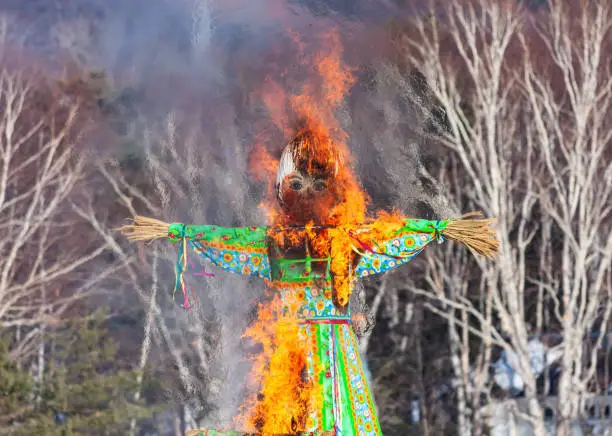What do you dream about Maslenitsa?

Maslenitsa, the Russian folk festival celebrating the end of winter and the onset of spring, is rich with symbolism and cultural significance. As an oracle, I delve into the dreams that feature this vibrant holiday, interpreting them through different perspectives and dream interpretations, incorporating insights from the renowned dream books of Miller, Vanga, Freud, and the Muslim Dreamer.
In the dreams where Maslenitsa serves as a backdrop, the first interpretation comes from Miller's Dream Book. According to Miller, dreaming of Maslenitsa indicates a time of joyful release and enthusiasm. It suggests that the dreamer may soon encounter a period of prosperity and abundance, akin to the bountiful pancakes that are central to the celebrations. This dream could symbolize the culmination of hard work, leading to a harvest of rewards. However, if the dreamer feels overwhelmed by the festivities or unable to partake in the joy, it may reflect anxieties about missing opportunities or a need to embrace life more fully.
Shifting to the perspective of Vanga, known for her mystical insights, a dream involving Maslenitsa can represent change and transformation. Vanga believed that such dreams are a harbinger of emotional renewal, a signal that the dreamer is shedding old patterns as winter gives way to the vibrancy of spring. The vibrant colors and indulgent foods of Maslenitsa symbolize the richness of life and the importance of embracing joyfulness. A deep longing for connection might also surface in this context; the dreamer may be urged to reconnect with loved ones and community, as the festival emphasizes unity and shared happiness.
From a psychological standpoint, the view of Sigmund Freud markedly diverges. Freud would likely interpret a dream of Maslenitsa focusing on the underlying desires and drives of the dreamer. He might suggest that the celebratory aspects of Maslenitsa relate to repressed desires for pleasure—perhaps associated with food, joy, or freedom. The act of eating pancakes in dreams could symbolize indulgence and the gratification of basic instincts. Alternatively, frustration over not being able to engage in the festivities could reflect a discontent with the dreamer's current life circumstances. The contrast between the festival's joy and personal dissatisfaction can elucidate the dreamer's inner conflict.
From the lens of the Muslim Dreamer, dreaming of Maslenitsa merges cultural nuance with spiritual interpretation. This perspective would focus on the connectivity and communal aspects of the festival, suggesting that a dream involving Maslenitsa indicates a need for harmony and balance in the dreamer's life. Such dreams could signify a spiritual awakening or a call to celebrate one's blessings and achievements. The festival's cheerful spirit may indicate a favorable phase where the dreamer is encouraged to give thanks and partake in acts of charity, fostering community ties. This dreaming context also hints at the significance of letting go of negativity, akin to the melting of winter snow, allowing for personal growth and renewal.
Visually, a dream representing Maslenitsa can be characterized by lively imagery—blurred faces of friends and family engaging in merriment, a pile of golden blini emitting steam as they serve warmth and sustenance, and the colorful decorations symbolizing life. Such an atmosphere might indicate an anticipation of imminent joy and communal success, but it could also reflect a conscious desire for connection—a yearning that possibly indicates underlying feelings of loneliness or isolation that need addressing.
As the dream unfolds, the dreamer's interactions during this festive period may provide additional insight into their psychological state. Engaging in playful activities such as sledding, singing, or dancing during Maslenitsa can signify a craving for freedom and playfulness in the dreamer's day-to-day life. Conversely, feeling excluded from the festivities presents an opportunity for introspection, an acknowledgment of the dreamer's current emotional state and their relationship with social circles.
Ultimately, dreams that bring forth the spirit of Maslenitsa are multilayered, inviting deep reflection across various axes of interpretation. They beckon the dreamer to explore their relationship with joy, community, and the cyclical nature of life. By examining these dreams through the paradigms of respected dream interpreters, the dreamer can align their waking consciousness with the insights gleaned during slumber, fostering a deeper understanding of self and the transformative experiences that lie ahead as winter gives way to spring.
So whether the dreamer is witnessing the joyfulness of Maslenitsa unfold or feeling its emotional resonance, the essence of this celebration translates into a universal message of hope, transformation, and connection—urging the dreamer to navigate their life with renewed enthusiasm and an open heart.





